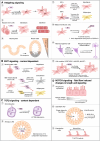Cilia at the crossroad: convergence of regulatory mechanisms to govern cilia dynamics during cell signaling and the cell cycle
- PMID: 40483459
- PMCID: PMC12144771
- DOI: 10.1186/s13578-025-01403-z
Cilia at the crossroad: convergence of regulatory mechanisms to govern cilia dynamics during cell signaling and the cell cycle
Abstract
Cilia are versatile, microtubule-based organelles that facilitate cellular signaling, motility, and environmental sensing in eukaryotic cells. These dynamic structures act as hubs for key developmental signaling pathways, while their assembly and disassembly are intricately regulated along cell cycle transitions. Recent findings show that factors regulating ciliogenesis and cilia dynamics often integrate their roles across other cellular processes, including cell cycle regulation, cytoskeletal organization, and intracellular trafficking, ensuring multilevel crosstalk of mechanisms controlling organogenesis. Disruptions in these shared regulators lead to broad defects associated with both ciliopathies and cancer. This review explores the crosstalk of regulatory mechanisms governing cilia assembly, disassembly, and maintenance during ciliary signaling and the cell cycle, along with the broader implications for development, tissue homeostasis, and disease.
Keywords: Cancer; Cell cycle regulation; Cilia; Ciliary dynamics; Ciliary signaling; Ciliopathies; Tissue development.
© 2025. The Author(s).
Conflict of interest statement
Declarations. Ethics approval and consent to participate: Not applicable. Consent for publication: Not applicable. Competing Interests.: The authors declare that they have no competing interests.
Figures





Similar articles
-
Involvement of Wnt signaling in primary cilia assembly and disassembly.FEBS J. 2020 Dec;287(23):5027-5038. doi: 10.1111/febs.15579. Epub 2020 Oct 19. FEBS J. 2020. PMID: 33015954 Review.
-
Cellular Mechanisms of Ciliary Length Control.Cells. 2016 Jan 29;5(1):6. doi: 10.3390/cells5010006. Cells. 2016. PMID: 26840332 Free PMC article. Review.
-
Microtubule-depolymerizing kinesins in the regulation of assembly, disassembly, and length of cilia and flagella.Int Rev Cell Mol Biol. 2015;317:241-65. doi: 10.1016/bs.ircmb.2015.01.008. Epub 2015 Mar 5. Int Rev Cell Mol Biol. 2015. PMID: 26008787 Review.
-
Epigenetically Mediated Ciliogenesis and Cell Cycle Regulation, and Their Translational Potential.Cells. 2021 Jul 2;10(7):1662. doi: 10.3390/cells10071662. Cells. 2021. PMID: 34359832 Free PMC article. Review.
-
Primary Cilia, Ciliogenesis and the Actin Cytoskeleton: A Little Less Resorption, A Little More Actin Please.Front Cell Dev Biol. 2020 Dec 17;8:622822. doi: 10.3389/fcell.2020.622822. eCollection 2020. Front Cell Dev Biol. 2020. PMID: 33392209 Free PMC article. Review.
References
-
- Sorokin SP. Reconstructions of centriole formation and ciliogenesis in mammalian lungs. J Cell Sci. 1968;3:207–30. - PubMed
Publication types
Grants and funding
LinkOut - more resources
Full Text Sources

